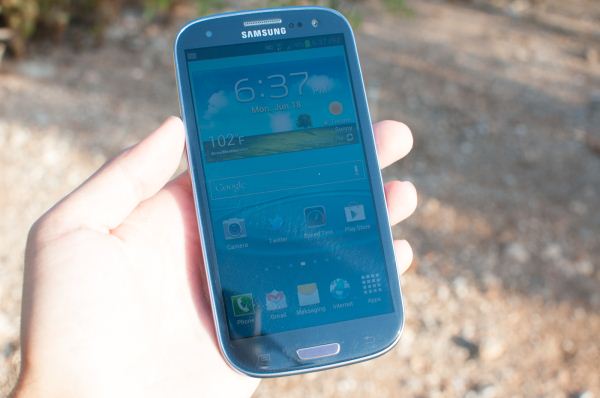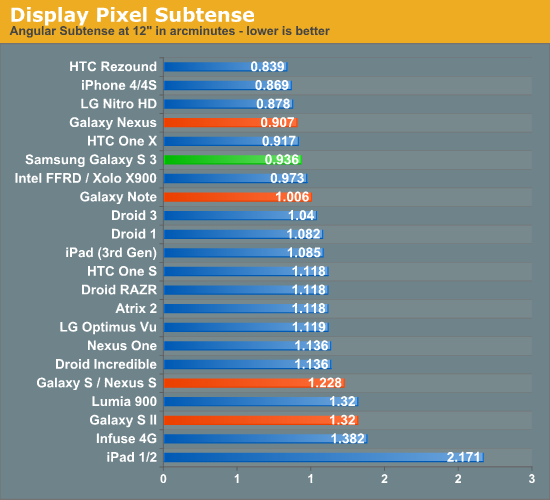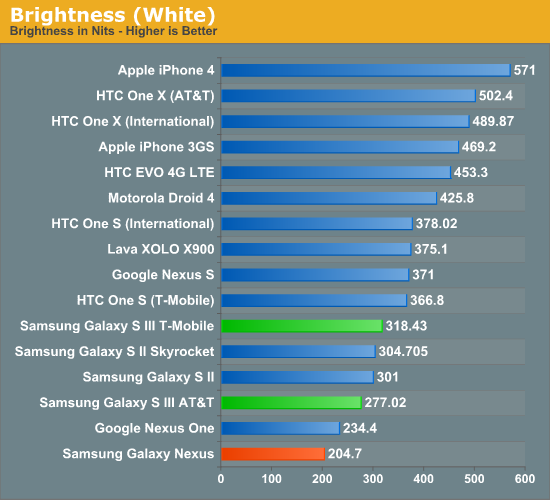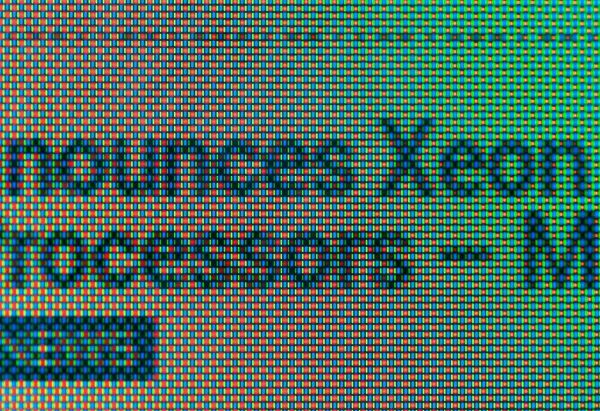Samsung Galaxy S III Review - AT&T and T-Mobile USA Variants
by Brian Klug on June 20, 2012 12:01 AM ESTOne of the standout features on the SGS3 is the 4.8" HD SAMOLED display, which has an effective resolution of 1280x720. Like other Samsung devices, the name tells you almost everything you need to know: HD connotes 720p, S for Super means the stack is optically bonded with fewer air gaps (and thus fewer fresnel 4% back reflections), and the lack of Plus means it’s an RGBG PenTIle subpixel matrix.
First off, it’s clear to me that the SGS3 display is a substantial improvement on the Galaxy Nexus display, which was 4.65" diagonal and also 720p HD SAMOLED. The problems that I talked about in the Galaxy Nexus display are basically completely absent in the SGS3. There’s no longer any mura (luminance variance which looks like noise) or a weird purple cast in the greys, two things that are still present on the Galaxy Nexus. I suspect that moving to a larger display with the same resolution (and thus larger subpixels) might have helped mitigate some of the mura, and in addition this appears to be a completely new revision of the process with none of those problems.

Outdoor viewing angles are pretty darn good
I think it’s also worth discussing PenTile once more - specifically in the context of whether or not you can see the pixels. At this point, I don’t think we need to go over what it is in much detail, but that it uses two sets of two subpixel units to achieve higher effective resolution than an RGB stripe. There are two variants - RG, BW which I’ve seen in a few Motorola LCD displays (that are Samsung), and RG, BG, which is the more common variant that is in all the AMOLED panels without the “plus” suffix.
The implementations that I complained loudest about were really the Nexus One and Nexus S / Galaxy S, where AMOLED was still somewhat in its infancy, and RG, BG was both a way to increase subpixel lifetime before fading took place (according to Samsung), and achieve a higher logical resolution with fewer subpixels than an RGB stripe would require. For that reason, you can’t really just evaluate a display with some boolean is garbage / not garbage based on the presence of PenTile alone. In theory, if the logical two-pixel cell is itself smaller than human visual acuity, then you shouldn’t be able to see it, and seeing the pixels is what drove me crazy about those two phones.
I present the following graph, which has the angular subtense in arcminutes along the stripe (when a device is held portrait, this is the x direction) of one logical pixel. That is to say, two subpixels if we’re talking about an RGBG PenTIle display, or three for an RGB display. For reference, human visual acuity is most often cited as being around 1 arcminute for the human vision system corrected to 20/20, which isn’t perfect vision (20/15 or slightly better is). Anything below that should be indistinguishable at a distance of 12 inches (standard viewing distance).

This is what I’m talking about when I say that in implementations such as the SGS3, even though PenTile is present, the logical pixel is still smaller than visual acuity, and the subpixels are half that. There’s still a case to be made for whether you can see fringing on black text on a white background to some extent, but personally I cannot see it.
So how is the display in other terms, such as brightness, color rendering, and viewing angles? For this I turned to the combination of my display colorimeter (still an i1D2), ColorHCFR, and Francois’s excellent Voodoo Screen Test Patterns.
When it comes to brightness, I found that oddly enough the T-Mobile and AT&T devices differed by a measurable and repeatable margin. Possibly these are from completely different batches, possibly there is some optimization done for the display brightness dynamic range to conserve battery - I’m not sure. Either way, it’s there, but the SGS3 is thankfully brighter than the Galaxy Nexus, though it still seems to be clamped to a fairly conservative number.

I measured blacks a few times and tried to see if I could get a reading on whether the SGS3 also has a slight DC bias (not fully off), but still couldn’t get anything. If it’s there, I haven’t noticed it yet.
In the Color HCFR testing, we can see that gamma looks very weird and nonlinear across the greys, going from around 2.4 down to 1.2, I have no idea what’s going on here. Color temp is thankfully a bit more controlled, at just under 7000K, and relatively flat.

I measured both devices after seeing that there was variance, and uploaded the color.chc files for both the AT&T and T-Mobile model for people with HCFR installed to check out. I’ve also made two galleries for the respective panels. I’ve heard really good things about the International SGS3 from Francois (supercurio), but haven’t measured it yet. I guess these initial numbers make me suspect that like SGS2 the USA variants have differences in the display rendering. I will say that over a range of brightnesses the SGS3 seems to have much less of the color shift compared to other AMOLEDs I’ve seen in the past.























107 Comments
View All Comments
shaolin95 - Wednesday, June 20, 2012 - link
As much as I loved my Captivate and thought the GS2 was a nice upgrade , the GS3 is a let down (the USA version that is).Say what you want about the dual core being close to the quad but I can score higher Browsermark with my Galaxy Note international (@1.6ghz) than the GS3 USA version. And the real killer is the older GPU.
I am going to wait for Note 2...likely international version as well if they keep messing things up.
BioHazardous - Wednesday, June 20, 2012 - link
It seems like it fails to impress in almost all tests, particularly battery life and WiFi performance. I wish the article was a little more critical of its shortcomings. The battery life is even less impressive when you consider it has a larger battery than the HTC One X.The only thing it really seems to have going for it vs the HTC One X is the microSD slot and removable battery.
When will the test results be added to the Bench?
IKeelU - Wednesday, June 20, 2012 - link
...for HTC. The SGS3 looks like a fantastic phone, but the benchmarks, camera, and battery tests all show one or more "One" variants slightly besting the SGS3.Both companies have done a great job, but I think my money will go towards HTC this time around. Specifically the One S. Thanks to its lower (but still great) resolution it's really killing those games benchmarks.
Mbonus - Wednesday, June 20, 2012 - link
I am very surprised that the SGIII was lagging in almost every benchmark to the HTC variants. My speculation is that Touchwiz must be incredibly invasive over the current version of Sense.One thing that needs to be tested is the multitasking. The HTC units have been reported to be very aggressive with killing background apps and some have speculated that this is how they are saving battery. It would be interesting to see how GSIII is handling multitasking.
redeemer777 - Wednesday, June 20, 2012 - link
Why are you so suprised? Both have the same chipsets which mean HTC has imposed better optimizations. This is Android guys root your phone, if you're not happy.Mbonus - Wednesday, June 20, 2012 - link
I'm most surprised in the battery department because of the physically larger battery of the SGS3.Impulses - Wednesday, June 20, 2012 - link
People shouldn't have to root their devices to fix some of the silly memory tweaks HTC did, and yes, their memory optimizations are currently too aggressive.Impulses - Wednesday, June 20, 2012 - link
I doubt dumping apps off memory to make more breathing room for Sense or whatever would help much with idle battery, it's not like you stop powering the memory either way.metafor - Wednesday, June 20, 2012 - link
One thing to keep in mind is that Samsung likely spends a lot more time tuning their software stack for their Exynos processors than they do for others. Whereas HTC pretty much starts out with Qualcomm chips.That being said, considering they are launching all of their US GS3's based on the S4, I'm surprised it didn't get their ultra-fast browser that we saw in the international GS3 preview.
patycake57 - Monday, June 25, 2012 - link
I,too, would appreciate knowing about the multitasking and how it compares with the One X. I bought the HOX (ATT) based on excellent reviews from many sites including this one, and have become more and more frustrated with the poor multitasking. Depending on your apps and pattern of usage, this may not bother you, but I cannot recommend the HOX to most that read AT (e.g. power users).I would very much like to see a first rate technical site like AT address multitasking, because for some, it can really alter the user experience beyond the technical specs/testing. Also, I think changes like this should be clearly disclosed by phone manufacturers, because if I would have known about this, I would not have purchased the HOX and waited for the SG3 or next Nexus phone. At this time, I'm not aware of a non-root fix, and HTC has not acknowledged it as a bug.